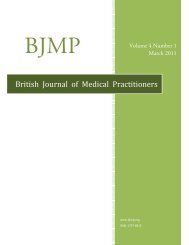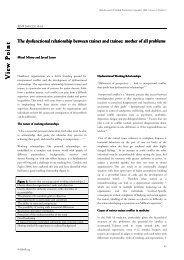R esearch A rticle - British Journal of Medical Practitioners
R esearch A rticle - British Journal of Medical Practitioners
R esearch A rticle - British Journal of Medical Practitioners
Create successful ePaper yourself
Turn your PDF publications into a flip-book with our unique Google optimized e-Paper software.
<strong>British</strong> <strong>Journal</strong> <strong>of</strong> <strong>Medical</strong> <strong>Practitioners</strong>, March 2013, Volume 6, Number 1<br />
BJMP 2013;6(1):a606<br />
Review A<strong>rticle</strong><br />
Management <strong>of</strong> Painful Peripheral Diabetic Neuropathy<br />
Namita Arora and Dr. G Niraj<br />
Abstract<br />
Diabetes Mellitus is an endocrine disorder which causes metabolic disturbance producing a state <strong>of</strong> hyperglycaemia. Hyperglycaemia adversely affects<br />
cardiovascular, renal, nervous and visual systems. The importance <strong>of</strong> good glycaemic control in these patients has been emphasised in literature to reduce<br />
the end organ damage. Diabetes can cause autonomic and peripheral neuropathy. The autonomic neuropathy can affect the cardiovascular, genitourinary<br />
and gastrointestinal systems. Peripheral neuropathy can cause acute and chronic sensorimotor neuropathy, which can cause significant morbidity in these<br />
patients affecting their daily activities and quality <strong>of</strong> life. It can be challenging to treat them because the pain can be resistant to the medication and the<br />
effective medication can be associated with adverse effects which the patients may find difficult to tolerate. It is very important to increase the dose <strong>of</strong> the<br />
drugs to their highest effective dose (within the therapeutic range <strong>of</strong> that drug) for each patient with a balance <strong>of</strong> the side effects caused by that drug in that<br />
patient. These patients <strong>of</strong>ten need more than one drug to provide adequate pain relief. There are guidelines and recommendations available to help the<br />
clinicians to use appropriate combination <strong>of</strong> available treatment options.<br />
Epidemiology:<br />
The WHO estimated that 171 million people had diabetes in<br />
the year 2000 and predicted this number to increase to 366<br />
million in the year 2030. Given the increasing prevalence <strong>of</strong><br />
obesity it is likely that these figures provide an underestimate <strong>of</strong><br />
future diabetes prevalence 1 . Peripheral diabetic neuropathy<br />
(PDN) may be present in 60 to 65% diabetic patients, with<br />
11% patients <strong>of</strong> diabetic neuropathy complaining <strong>of</strong> pain. The<br />
management <strong>of</strong> this condition can be particularly challenging as<br />
these patients may not get good response to the medications<br />
used for the treatment and the medications used are associated<br />
with side effects which the patients may find difficult to<br />
tolerate.<br />
Pathophysiology:<br />
Pathophysiology <strong>of</strong> PDN is complex and incompletely<br />
understood. Both peripheral and central processes contribute to<br />
the chronic neuropathic pain in diabetes. Peripherally at the<br />
molecular level due to hyperglycaemia, glycosylated end<br />
products are generated, which deposit around the nerve fibres<br />
causing demyelination, axonal degeneration and reduction in<br />
nerve conduction velocity. Deposition <strong>of</strong> glycosylated end<br />
products around the capillary basement membrane causes<br />
basement membrane thickening and capillary endothelial<br />
damage, which in association with a hypercoaguable state causes<br />
peripheral arterial disease. The peripheral arterial disease leads<br />
to neuronal ischemia which worsens nerve damage. There also<br />
occurs depletion <strong>of</strong> NADPH by activation <strong>of</strong> NADPH oxidase<br />
causing increased oxidative stress and generation <strong>of</strong> oxidative<br />
free radicals which aggravate the nerve damage. Calcium and<br />
sodium channel dysfunction, changes in receptor expression are<br />
the other peripheral processes which cause further neuronal<br />
tissue injury. The nerve damage can cause neuronal<br />
hyperexcitability. Neurotropic factors are required for nerve<br />
regeneration. In diabetes there occurs a low level <strong>of</strong> both nerve<br />
growth factors and insulin-like growth factors resulting in<br />
impaired neuronal regeneration. This can lead to peripheral<br />
hyperexcitability. Central sensitization is cause by increased<br />
excitability at the synapse, which recruits several sub-threshold<br />
inputs and amplifies noxious and non-noxious stimuli. Loss <strong>of</strong><br />
inhibitory interneurons, growth <strong>of</strong> non-damaged touch fibres<br />
into the territory <strong>of</strong> damaged pain pathways, increased<br />
concentration <strong>of</strong> neurotransmitters and wind up caused by<br />
NMDA receptors are responsible for central sensitization at the<br />
level <strong>of</strong> dorsal horn in the spinal cord 2 .<br />
Clinical Presentation:<br />
Chronic sensorimotor distal polyneuropathy is the most<br />
common type <strong>of</strong> diabetic neuropathy. Acute sensorimotor<br />
neuropathy is rare and is usually associated with diabetic<br />
ketoacidosis and acute neuritis caused by hyperglycaemia.<br />
Autonomic neuropathy is common and <strong>of</strong>ten under reported. It<br />
can affect cardiovascular, gastrointestinal and genitourinary<br />
system. The other presentations can be cranial neuropathies,<br />
thoraco-abdominal neuropathies or peripheral<br />
mononeuropathies involving median, ulnar, radial, femoral,<br />
lateral cutaneous nerve <strong>of</strong> the thigh or common peritoneal<br />
nerve.<br />
The patients usually complain <strong>of</strong> one or more <strong>of</strong> the following<br />
symptoms. They can have a chronic continuous or intermittent<br />
pain described as burning, aching, crushing, cramping or<br />
gnawing pain. The pain can be associated with numbness. They<br />
BJMP.org<br />
12







